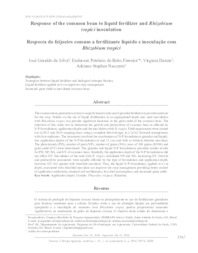Response of the common bean to liquid fertilizer and Rhizobium tropici inoculation.
Response of the common bean to liquid fertilizer and Rhizobium tropici inoculation.
Author(s): SILVA, J. G. da; FERREIRA, E. P. de B.; DAMIN, V.; NASCENTE, A. S.
Summary: The common bean production system is majorly based on the use of granular fertilizers to provide nutrients for the crop. Studies on the use of liquid fertilization at an appropriated depth and, seed inoculation with Rhizobium tropici can provide significant increases in the grain yield of the common bean. The objective of this study was to determine the growth and productivity of common bean as affected by N-P formulations, application depths and the inoculation with R. tropici. Field experiments were carried out in 2015 and 2016 cropping years using a complete block design, in a 2x2x2 factorial arrangement, with four replicates. The treatments involved the combination of N-P formulation (granular and liquid), two application depths of the N-P formulation (6 and 12 cm) and with or without rhizobia inoculant. The plant density (PD), number of pods (NP), number of grains (NG), mass of 100 grains (M100) and grain yield (GY) were determined. The granular and liquid N-P formulations provided similar results for PD, NP, NG, and GY of common bean. Similarly, the application depth of the N-P formulations did not affect GY. Inoculation of the seed with R. tropici stimulated NP and NG, increasing GY. Growth and productivity parameters were equally affected by the type of formulation and application depth; however, GY was greater with rhizobial inoculant. Thus, the liquid N-P formulation, applied at 6 cm depth, associated with rhizobial inoculant can improve the crop management providing better control of application uniformity, minimal soil mobilization, less fuel consumption, and increased grain yield.
Publication year: 2020
Types of publication: Journal article
Unit: Embrapa Rice & Beans
Observation
Some of Embrapa's publications are published as ePub files. To read them, use or download one of the following free software options to your computer or mobile device. Android: Google Play Books; IOS: iBooks; Windows and Linux: Calibre.
Access other publications
Access the Agricultural Research Database (BDPA) to consult Embrapa's full library collection and records.
Visit Embrapa Bookstore to purchase books and other publications sold by Embrapa.

